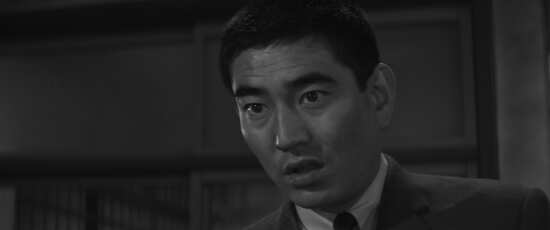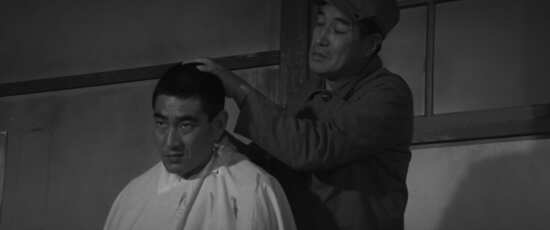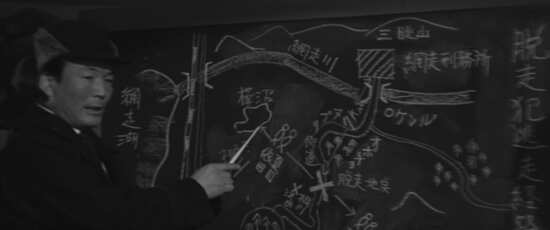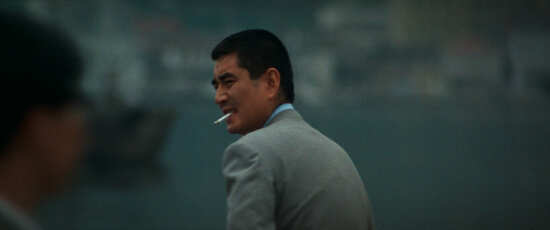Review for Prison Walls: Abashiri Prison 1-3
Introduction
Is it possible to be a fan of a genre as specifically defined as the prison movie? How many variations on this particular theme, of people confined behind bars can there be? How many of them can be notable? I mean, not every film will be The Shawshank Redemption, or The Great Escape, or The Birdman of Alcatraz. And I can’t think of watching more than one such film in a row. I’d need to mix things up a bit to keep things interesting. But it turns out that people can become fans of such tiny little niches. Abashiri Prison came out in 1965. Over the next seven years, they made 18 Abashiri Prison movies, all of them starring Ken Takakura. That’s a little too obsessive even for me. Maybe we can better define it by director. The first Abashiri prison was directed by Teruo Isshi. And he went on to direct nine more of them, before he tired of the franchise. Maybe it’s about the format, after all the first film in the series is monochrome. But thereafter the films are in colour.
So it seems a little arbitrary that Eureka Films are releasing the first three of the Abashiri Prison films as the Prison Walls collection. Perhaps they know something I don’t, that these three are the best in the franchise, or they know the threshold of tolerance I have for a genre I’m not a fan of, before I start tearing my hair out. Three prison movies ensue.
Abashiri Prison I and II are presented on one disc, while Abashiri Prison III gets a disc to itself courtesy of Eureka Entertainment. The images in this review were kindly supplied by Eureka Entertainment.
Introduction: Abashiri Prison
Shinichi Tachibana has been sent to prison for a crime he did commit, although his upbringing was such that it’s hard to see how he wouldn’t have wound up in organised crime. He’s been sent to Abashiri Prison, cold, snowbound and isolated, and he and his fellow newcomers are assigned to a prison cell with half a dozen veterans, the group assigned various tasks of hard labour. The social hierarchy within the cell is complicated enough, but then throw in the prison officers, and Shinichi is torn between good behaviour in the hope of an early parole, and living down to his fellow inmates expectations of a yakuza. The dilemma goes up a level, when he learns that his mother is seriously ill, while his fellow inmates plot an escape.
The Transfer: Abashiri Prison
The first Abashiri Prison film gets a 2.35:1 widescreen 1080p monochrome transfer, with PCM 2.0 Mono Japanese audio and optional English subtitles. The image is clear and sharp, and free of any print damage or signs of age. Contrast is good, and there is a nice level of filmic grain. While the prison sets are very obviously sets, there is a decent amount of location work in the film that really impresses. The audio is fine, the dialogue is clear, and the subtitles are timed accurately and are free of typos.
Extras: Abashiri Prison
Both discs present the content with static menus. The first film gets an audio commentary from Tom Mes, and a theatrical trailer that runs to 2:45
Conclusion: Abashiri Prison
There’s this interesting thing about prisons depicted in Japanese cinema, the idea of a society within a society. You get 12 or so inmates in one large cell area, and they are expected to form a community among themselves, following the traditional senpai and kohai dynamics, seniors looking after juniors. There’s a twist in that they are convicted felons, and not exactly the most upright of citizens, but it’s a kind of social dynamic that you just don’t associate with prisons and criminals. It’s a curiously Japanese phenomenon where even the criminal classes are socially stratified and regimentally formal, and no matter how many times I see it depicted in film, I can never believe it’s real. It’s not exactly the same thing as Fletcher taking Godber under his wing in Porridge.
So as you might guess, I had a hard time getting on with Abashiri Prison. It also didn’t really appeal to me that this is really just a character study of Shinichi Tachibana, the yakuza turned inmate who arrives at Abashiri prison, a little out of his depth, and faced with a series of moral dilemmas, on whether to be a model inmate, or to live down to his yakuza reputation. The other characters in the story seem like good angels and bad devils, temptations and moral signposts that he encounters on his path as a prisoner. The film does a good job of developing his character through flashbacks, showing his home life from childhood onwards, a family at the mercy of an abusive father.
At first the idea of getting an early parole seems academic at best, a positive of getting out early, but no other motivation than that to do so. Odd pranks and moments of anti-authoritarianism seem to balance playing nice with the system. But when his mother becomes ill, at the same time as his fellow inmates coming up with a serious escape plan, the dilemma becomes more real and immediate. Abashiri Prison is a well made film, and an interesting story, but I just couldn’t connect with it, or its characters.
6/10
Introduction: Abashiri Prison II
Shinichi Tachibana has done his time. He’s been released from prison, and is now making the journey back home via the ferry in Hakodate. It’s a strange ferry trip too, full of interesting passengers, and no few criminals, as Shinichi learns when he literally bumps into an attractive pick-pocket. Of more interest is the mysterious nun with a box full of fake algae ball souvenirs. When one of those algae balls is stolen by Shinichi’s partner, all hell breaks loose. Soon, Shinichi, his partner and the lady pickpocket are framed as suspects in a murder. Everyone wants that algae ball, as it’s linked to a bank robbery where precious jewels were stolen.
The Transfer: Abashiri Prison II
We’re in colour now, the success of the first film obviously affording the hastily produced sequel an increased budget. The film gets a 2.35:1 widescreen 1080p transfer on this disc with PCM 2.0 Mono Japanese audio and translated English subtitles. The image is pretty good for this film, clear and sharp, with consistent colours, and decent level of film grain. Contrast is well balanced, and detail levels impress. Signs of age are apparent, with the occasional fleck or minor bit of print damage on screen, but there are no glaring issues with the transfer. The first film’s winter locations and prison sets suited the monochrome format well, but here we get a lot of Japan’s nightlife, and all those neon lights and vivid fashions deserve colour. The audio is fine, presented without problem, and the subtitles are accurately timed and are free of typos.
Extras: Abashiri Prison II
The second film on the first disc gets an audio commentary from Chris Poggiali, and you also get the theatrical trailer (2:50).
Conclusion: Abashiri Prison II
There may be a case for false advertising here, as the only sight of a prison in this film is in the title. We see one prison officer transporting a prisoner at the start of the film, but as for an actual building with bars, locks and cells, there’s not a single trace. On the other hand, why would I complain about Abashiri Prison II when I enjoyed it so much more than the first film? I don’t exactly go looking for prison dramas, but when it comes to crime capers, which this second film is, I’m a lot more amenable. Abashiri Prison II is more of a light drama with comic overtones, and as such I found it to be a lot easier to watch, with plenty of interesting characters to appreciate, and a sense of physical motion complementing the film’s pace.
It does still have that take on Japanese society and the Japanese underworld that I find hard to connect with, the way that criminals are seen as cool, and even heroic by the average person in the street (see the women acting as groupies around a suspected murderer at the start of the film), as well as the social hierarchy and regimented formality with which criminals interact with each other. But this isn’t the point of the story this time.
This time around, it’s all about the Maguffin. In Pulp Fiction it was the golden glowing briefcase; here it’s a counterfeit algae ball, whatever that is, which an erstwhile nun loses at the start of the film, and which the various protagonists and antagonists spend the runtime of the movie hunting down, willing to do anything to get their hands on it. It goes on quite the journey in this film, pursued by Tachibana and his friends, and the villains of the piece.
The tonal shifts should be jarring, but surprisingly aren’t in this film, most likely as the tones are character specific. The film begins with the bank robbery, where it quickly becomes apparent that security guards are little more than targets, and that there is no honour among thieves. But then we shift to the Hakodate docks, where we’re reunited with Shinichi Tachibana, and we meet the other various characters that will play a part in the story, and the tone becomes lighter, and often comedic. The villains bring the threat, and the protagonists keep it light, even if it takes a minute to figure out which is which.
Still, I really enjoyed Abashiri Prison II, especially given the genre shift. I don’t think I could have taken another ninety minutes behind bars.
7½/10
Introduction: Abashiri Prison III
Shinichi Tachibana has finally made it home to Nagasaki, and unsurprisingly he walks into trouble. As a young punk, a member of the Asahi yakuza group, he’d left Nagasaki under a cloud, when he took matters into his own hands to avenge his boss against the rival Yasui gang. Having spent time in Abashiri Prison has given him a different perspective, a perspective that is focused when he runs into a mischievous orphan girl named Emi on the Nagasaki docks. But the rivalry between the Asahi and the Yasui gangs has only intensified over the years, and Shinichi can’t help but be pulled back in.
The Disc: Abashiri Prison III
The transfer on Abashiri Prison III is on a par with the previous film for the most part. The 2.35:1 widescreen 1080p colour transfer is clear and mostly sharp, with good detail and strong, consistent colours. With the contrast also impressive, that helps make the most of some impressive location photography. But I did notice print damage in this film more often than in the first two. The mono audio is perfectly acceptable, warm and rich with no sign of distortion or dropout. The subtitles are accurately timed and are free of typos.
Extras: Abashiri Prison III
With the third film, you get an audio commentary from Mike Leeder & Arne Venema, and the original theatrical trailer which runs to 2:21.
The second disc also has a couple of general featurettes for all three films.
Break Out: Jasper Sharp & Mark Schilling Discuss Abashiri Prison (29:26)
Interview with Tony Rayns (30:41)
Conclusion: Abashiri Prison III
Abashiri Prison gets a mention or two in this third movie, but that’s as close as it gets to the penitentiary. The second film shows what happens straight after Shinichi Watanabe is released from prison, but this third film is about going back, or rather avoiding going back. It’s another genre switch, which at least makes this collection more watchable if you don’t want to be burned out by a single genre, but this is the most conventional movie of the three. A yakuza flick.
This disc kicks off with the kind of trigger warning that Studiocanal seems to put on every film made before 2010 that they release these days, but in this case this Eureka’s warning is justified. After all, the orphan girl Emi is played by a Japanese actor in blackface, a girl born of a liaison between a foreigner and a Japanese woman, and abandoned after her mother’s death. It’s very much a product of its time and the homogenous culture of the nation where this film was made. But it is still one of those films where you have to rewire your brain for the duration, and sometimes that’s just not possible.
I did find the third film in the series to be somewhat generic when it comes to yakuza crime movies. A guy with a past returns to his home town to wind up in the middle of a conflict between rival gangs. While he reconnects with the people he had left behind, he’s determined to stay on the straight and narrow, despite the provocations thrown his way. Of course there will come a point where those provocations cross an invisible line, and he has no choice but to pick up a weapon once again, and retribution will ensue.
There are countless films like this, so your appreciation of this third film will depend on how much you’ll have invested in the Shinichi Tachibana character over the course of the first two films. For me, the third film was just too generic for me to get into.
6/10
In Summary
On the one hand, you could accuse this collection of false advertising, three films called Abashiri Prison, but only the first film is a prison movie. As a reviewer however, I would probably have burned out if I had to watch three prison movies in a row, as it’s hardly my favourite genre. One was enough, and its monochrome visuals merely added to my inability to enjoy the first film. But the second film is a crime caper, something I can get behind more easily, and even if Abashiri Prison II blends its lighter moments of humour with some atonal brutality, I still enjoyed it. The third film on the other hand is rather more generic a yakuza movie, and your mileage may vary depending on how much you enjoy that genre. When it comes to the Abashiri Prison film franchise, these three films merely scratch the surface, but they are a nice way to dip your toe into the series. Prison Walls: Abashiri Prison I-III is available direct from Eureka Entertainment, from Terracotta, and from mainstream retailers.

























































































Your Opinions and Comments
Be the first to post a comment!